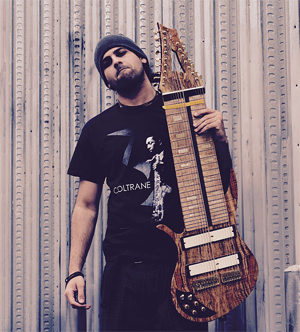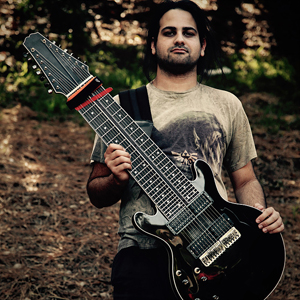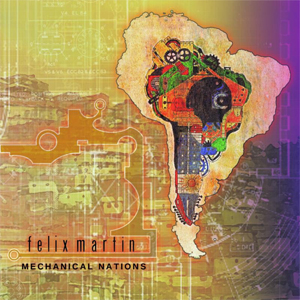Felix Martin came to the U.S. from his home country of Venezuela to attend the Berklee College of Music. He was already a gifted guitarist by the time heíd arrived and would go on to develop a technique whereby he plays two guitar necks simultaneously. This eventually led him to have instruments built that feature dual guitar necks, one atop the other. He plays using a tapping style and his guitars vary in configuration from twin 7-string guitars to one featuring 9-strings and 7-strings.
While attending Berklee, Martin met bassist Kilian Duarte and drummer Victor A Carracedo and Martinís progressive trio was formed. The bandís sound is rhythmic and syncopated with an underlying groove that drives each song. Fans of heavy instrumental music and progressive alike will find it very appealing. Martin is releasing the album Mechanical Nations on February 24th and the first two tracks, which have already been made available, are getting a lot of attention.
Hereís what Felix Martin and Kilian Duarte told KNAC.COM about their very unique style of music and the upcoming album.
KNAC.COM: Early on, what type of music were you drawn to, artists and genres that helped shape your style?
MARTIN: I developed my guitar technique playing traditional Venezuelan music as well as folk, Latin and jazz. I have so many different influences, basically every genre of music. I didnít learn how to play the guitar by playing progressive rock. My influences are really broad and include everything from classical to folk to death metal to pop.
DUARTE: My parents are big fans of progressive rock and jazz-fusion, so thatís what I always heard growing up. Like Felix, I listened to almost every type of music. Obviously, I had my bass influences such as Jaco Pastorius, Victor Wooten and the traditional ones, but really it came from immersing myself and trying to learn music. I grew up with MTV and VH1 when those things were still relevant, so I remember absorbing all of it.
MARTIN: We also went to college together. If you go to a music school, you have to play everything and know different styles of music. Going to a music college was a big influence on us both because it required us to really know and understand every style.
 KNAC.COM: What led to the development of your multiple neck guitars and building them with the necks in phase rather than in a Chapman stick fashion with the bass strings and melody strings working their way outward from central low strings?
KNAC.COM: What led to the development of your multiple neck guitars and building them with the necks in phase rather than in a Chapman stick fashion with the bass strings and melody strings working their way outward from central low strings?
MARTIN: Essentially, what Iím doing is just playing two guitars at the same time. All of my guitars are either 14-string or 16-string and are all two guitars together with the same sound. The Chapman stick and the Warr guitar are different. Theyíre like a bass and a guitar together. My guitars are two guitars in one.
Iím a guitar player, not a Chapman stick or bass player. It began with me playing two guitars at the same time using the tapping technique. Iíd play standing up with one guitar and have another on a table. Eventually, I had two guitars joined together with the same feel and the same sound. Playing like that felt very natural to me. It didnít feel as natural playing finger-style or classical guitar, but more so to play tapping. Thatís how I came up with the idea for my guitar.
The Chapman stick and Warr guitar are different instruments. Like you mentioned, with those instruments, one side of the strings is upside down and the low strings are in the middle. Neither of those instruments are guitars or basses, though. Theyíre touch style instruments. Personally, I donít play the Chapman stick. Iím a guitar player, so itís not necessarily that easy for me to switch over to a Chapman stick. I can probably play a few notes, but itís just really different.
KNAC.COM: As a left-handed guitarist, was it difficult to teach yourself to play right-handed in order to play the double neck guitar?
MARTIN: I gained the strength and endurance a long time ago. When I was about 13 years old, I used to practice my chops, such as METALLICA solos, with both hands. Iíd practice them first with my right hand, as a left-handed guitarist and then with my left. Learning to play the same part with both hands also helped me develop limb independence. Itís pretty simple, but it takes awhile to build up endurance.
KNAC.COM: Given the complexity of this type of music, what is your approach to song writing? How are your songs structured?
MARTIN: First, I just sit down with the guitar and write some ideas, mixing parts together. Eventually, I may combine several of them into one song, but mixing various ideas can be a big challenge. Writing transitions between different sections of songs is particularly difficult. I try to imagine a song in my head before I write it, so thatís actually kind of a hard question to answer.
DUARTE: For me, itís more about adapting around Felix. Given how the guitar parts are structured, people might think thatíd be difficult, however; because heís so rhythm-section-minded, itís actually kind of easy to write parts around him. The difference between this band and a lot of other guitar-led bands is that the rhythm section is a big part of the compositional element. Itís not just playing 8th notes behind a guy doing guitar solos. Both guitars and how Felix uses them are very rhythmic and textural, so it lends itself to coming up with cool and unique ideas.
Many times, rhythm parts have to be syncopated due to the nature of what weíre writing. Weíre lucky in that, since we started, weíve always had excellent drummers. I donít recall ever playing with a mediocre one and the music lends itself to developing rhythmic ideas.
Everything starts with Felix. The songs are his babies. The drums add another layer of texture and then I come in at the end and add my own stamp. Itís mostly complete by the time I enter the process, but I certainly come up with ideas that enhance it. Surprisingly, the music is very easy to write because itís made for a rhythm section. Thatís probably one of the most fun parts about it. Itís guitar music, but a rhythm-section person will greatly enjoy it.
 MARTIN: Yeah! Itís much more band-based, rather than just soloing. The new album sounds much more like a band playing. Weíre releasing a song on Monday (ďFlashbackĒ Ė released February 13th) and that one, in particular, features the whole band playing all of the time. All of its syncopations are in unison. I guess you just have to hear it. Itís hard to explain.
MARTIN: Yeah! Itís much more band-based, rather than just soloing. The new album sounds much more like a band playing. Weíre releasing a song on Monday (ďFlashbackĒ Ė released February 13th) and that one, in particular, features the whole band playing all of the time. All of its syncopations are in unison. I guess you just have to hear it. Itís hard to explain.
KNAC.COM: Your upcoming release Mechanical Nations was self-produced and mixed by Jamie King. What was your experience working with him?
MARTIN: I produced it, Jamie and I mixed it together and then he did the mastering. It was a long process. At first, I wrote about 50 songs because I wanted to take a break and just needed to write. I didnít want to write a 10 or 15 song album. Rather, I wanted to put down about 50 songs and pick the 15 that made sense for a new album. After I finished those songs, I rerecorded them in the studio. I rerecorded the drums, as well. We started with a live scratch track of the drums, so we ended up recording them three times. I like to write drum parts while Iím writing the guitars so that I have the whole composition done. Then Iíll work with our drummer writing several alternate versions and takes with different grooves. Kilian comes in when weíre recording the final bass tracks.
I did all of the production for Mechanical Nations, the editing and other boring stuff. Jamie and I spent six months mixing it together and he mastered it. But again, this album is very band-based. There are no strings, piano or backing tracks in there. It didnít require too much production. I didnít even record my guitars twice. Everything you hear on the album is just one guitar. Iím not double tracking, so it sounds more like a live band.
KNAC.COM: Listening to your 2012 release Live In Boston and realizing youíre about to head out on a Northeastern U.S. tour, Iím wondering how you go about keeping it together live. How do you prepare as a group and are there particular signals or count outs for the myriad time changes?
MARTIN: It was a nightmare doing Live In Boston. Back during those college days everyone was really busy. Iíd have four drummers for one concert and each would learn three songs. Itís not as though I had an album. I wrote the material and then we performed at Berklee. We didnít have any backing tracks or click tracks for the drummer. It was all done live and it was tough.
DUARTE: The live album was recorded while we were still in school. It was just a really nice recital that ended up being of quality that we could release. It was a lot of fun and very organic sounding. As for right now, our live show comes down to good old rehearsal. Our drummer is fantastic and we put a lot of effort into rehearsing ahead of time. Victor does use a click track just to maintain some order, but apart from that, when you see us, itís no frills, no backing track. Itís just a matter of us going for it. Felix is very animated on stage. Iíd like to think I am, too, and Victor is definitely very hard-hitting. We try to perform the way a good rock band would, not like a bunch of prog guys sitting there staring down at the ground or looking at their fingerboards. We put a bit more emphasis into it.
To answer your question, how do we do it live? Itís just practice. Felix practices a ton and before we go on tour I make sure to shed a lot. Weíve been very lucky to always have excellent drummers, too, be it Victor or one of the ones prior to him. We donít have to worry about the drums dragging or rushing because theyíve all been solid guys who could shred.
Felix and I have been playing together since 2009, so we understand one anotherís energies on stage. Over the years you get better at having levels, understanding what you need to perform live and dialing in sounds.
 MARTIN: When Iím auditioning drummers, they have to be musicians. Itís important that they know music theory, because once people know theory, they can play anything. They understand the music. If you take this material to people who donít read music, itíd be really tough for them to follow. There are so many things going on in the music that, if you donít know theory, you will get lost.
MARTIN: When Iím auditioning drummers, they have to be musicians. Itís important that they know music theory, because once people know theory, they can play anything. They understand the music. If you take this material to people who donít read music, itíd be really tough for them to follow. There are so many things going on in the music that, if you donít know theory, you will get lost.
DUARTE: The band functions very much on feel at this point. We donít think about what time signature something is in. Itís more about the groove. When weíre live, weíre on autopilot. The only cue we get is when Victor counts us in for each song. Once weíre there, we pretty much function on autopilot for the rest of the song. I know what the time signatures are, but when Iím playing live, Iím not thinking about them. Iím just feeling grooves.
MARTIN: I had a drummer once who would count everything, but thatís really hard. I donít do that. You have to learn the groove and the feel.
KNAC.COM: Back to Mechanical Nations, I understand you want the music to capture the feel of industrialized South American countries such as your home country of Venezuela while also exploring more unique sound qualities of the electric guitar. How will this differ from your prior material and how would you describe this new tone?
MARTIN: The previous album was a little more progressive. There was a lot going on, a lot of changes in the songs. The first song on the last record had maybe seven different rhythms or parts. The music on this album is much easier to understand, but itís also more technical. I guess the level of difficulty is about the same. This one is just more digestible than the previous one.
Mechanical Nations also features influences from Latin music. The second song on the record has a Latin feel to it as does the song ďEight Moon HeaddressĒ.
DUARTE: This album is much more accessible in a lot of ways, which is cool if you understand whatís going on. Weíre doing some of our most technical work on this record, but it doesnít sound technical for the sake of being technical. The groove is there. You can bob your head to it. Itís music you can listen to in your car with your friends. Especially the single ďFlashbackĒ, which hits you really hard or ďBOMĒ with its main riff. Thereís still a melody that catches you and the groove is everything, but we havenít lost the technicality of the band.
The drums on this record are some of the most active weíve ever had, and while I move around less linearly on the bass, itís more fun rhythmically for me. Felix goes all out using his guitar not just as lead, but really exploring it rhythmically.
MARTIN: Iím doing the same thing as the drummer on this album, essentially interpreting drum parts with my instrument. Thereís a lot of percussion in what I do. The resulting sound isnít as much that of me soloing, but more that of a whole band. Kilian also contributed a lot to the sound on this record because Iím using an 8-string and a 9-string guitar most of the time.
DUARTE: This is my first venture into fanned fret. Iíve been exploring it with my new J Ferro signature build and itís a trend that makes sense because the tension on the low strings is great. I was able to get my first fanned fret bass on this record and the songs in A-flat didnít sound warbly at all. We actually explored different tunings for the first time. Even though some of them are in standard, sometimes we do drop. We also go into different keys than we did previously. Thereís a lot of C-sharp, F-sharp, a lot of flats.
 Some bands tend to gravitate toward a single key. This record goes through the gamut, which is nice because each song has its own palette. Something that Iíve always liked about this band is that each song sounds completely different. Iím sure youíve listened to metal bands where the whole album is just a collection of riffs. When trying to decide which song you like best, you realize it was kind of a blur. With Felix and this band, every song has its own identity, so listeners can really attach to them.
Some bands tend to gravitate toward a single key. This record goes through the gamut, which is nice because each song has its own palette. Something that Iíve always liked about this band is that each song sounds completely different. Iím sure youíve listened to metal bands where the whole album is just a collection of riffs. When trying to decide which song you like best, you realize it was kind of a blur. With Felix and this band, every song has its own identity, so listeners can really attach to them.
MARTIN: I do a lot of percussion and low notes on the 8-string guitars, so the idea was for Kilian to go lower than 8-strings. Otherwise, the two would clash. When you play percussion on the guitar itís easy to fall out of tune. Especially for me, because when I do percussion on the guitar, I like to play hard. It took some experimenting with this album, and in the beginning, it was tough. With me doing percussion on the guitar, one of the things I had to do to make the bass sound better was drop the bass an octave lower than standard tuning.
KNAC.COM: Are there particular people who just get progressive music or is there material that appeals to those who also like more traditional music? Is Mechanical Nations decidedly progressive or does its sound have a more diverse appeal?
MARTIN: There are some people who only listen to prog and complicated music. I was one of them. When I was 15-21 years old, I only listened to progressive metal/rock, jazz-fusion or super crazy jazz. There are people like that, for sure. This record will appeal to a broader audience. I didnít plan for that to happen. It just came about naturally as part of the writing process. The songs on Mechanical Nations will appeal to anyone who likes metal or rock, not just prog fans.
DUARTE: Felix nailed it. We didnít lose any of the musicís technicality, but this time the groove and melody are more memorable. Thereís more pocket in a lot of the things weíre doing. The rhythm section is driving and the guitars are really aggressive. Again, itís something you can listen to in the car with your friends without people thinking youíre a weirdo. [Laughing] If you take your date out and put on Close To The Edge by YES, sheís going to think youíre kind of a weird dude unless sheís down with that stuff. You know what I mean?
We still have progressive elements, like the tapping runs at the end of ďBOMĒ but itís not something thatís inaccessible. Itís something you can groove to. Itís not music a guitar kid would listen to by himself in his room simply because he plays the guitar. Even if you donít play instrumental music, youíll still enjoy it.
KNAC.COM: You recently released the track ďBOMĒ from the new record featuring a guitar with 7 strings on top and 9 on the bottom rather than and a twin-8-string neck variant. How do the various versions of your twin neck guitars allow you to change the shape of your sound?
MARTIN: I experimented with alternate string setups because all of my guitars sound really different and I write different music with each one of them. It was cool having three new guitars with me when I was writing this album each one of which gives me different ideas. My main setup right now is two 8-string guitars together such as the headless guitar. Iíve experimented with two 7-strings, a 7-string with an 8-string, two 8-strings and then a 9-string with a 7-string. The one I use in ďBOMĒ is the 9-string-7-string combination. Thatís more of a specialized guitar and I only use it for four or five tracks on the record. The setup I feel most comfortable playing is that with two 8-strings guitars together.
 KNAC.COM: It seems that more truly innovative and gifted artists are choosing the route of schools such as Berklee. Is there an environment or culture at these institutions that pushes or inspires musicians beyond what they might otherwise do on their own?
KNAC.COM: It seems that more truly innovative and gifted artists are choosing the route of schools such as Berklee. Is there an environment or culture at these institutions that pushes or inspires musicians beyond what they might otherwise do on their own?
MARTIN: Yes, of course. The main thing about schools such as Berklee is having the opportunity to be surrounded by so many musicians. Nowadays, we go to the NAMM show to find inspiration for the rest of the year. When youíre at Berklee, youíre studying with so many great musicians, the best in the world. You see them playing, writing, recording in the studios and there are concerts everyday. Being at Berklee is tremendously inspiring. You wake up, get inspired, go home and practice all day.
DUARTE: Itís not as though you canít achieve these things without music school, because plenty of people do. Thereís the old adage that goes, ĎYouíre as good as the company you keep.í Being surrounded by people who are all striving to be excellent drives you to not be lazy. Looking back, our first drummer, JP Boubet, played with Steve Vai and all of those guys from "Generation Axe". Matt Garstka is in ANIMALS AS LEADERS. Iíve played with Paul Wandtke who was in TRIVIUM and NILI BROSH. Iíve known all of them since we were 18 years old. Being around those types of people and growing up in that environment, especially when you see them pushing themselves, makes you strive to go to that next level. If youíre sitting on your ass, you feel pretty lazy by comparison.
For me, music school has paid off over time because of networking. Every person has his or her own unique path through music, but being in the music school environment has definitely helped me on mine. I think Felix would feel the same way.
MARTIN: Itís not so much about the classes, but more about the people that you meet and the inspiration that comes from being around them.
Until youíve heard Felix Martinís music and seen him play, thereís no way to adequately describe his work. Itís really something to behold. His prior material is addictive and the new material even more so. Heís headed out on a Northeastern U.S. tour beginning March 8th and I, for one, am very much looking forward to seeing him and the whole trio perform live.
You can order Mechanical Nations at the following links:




